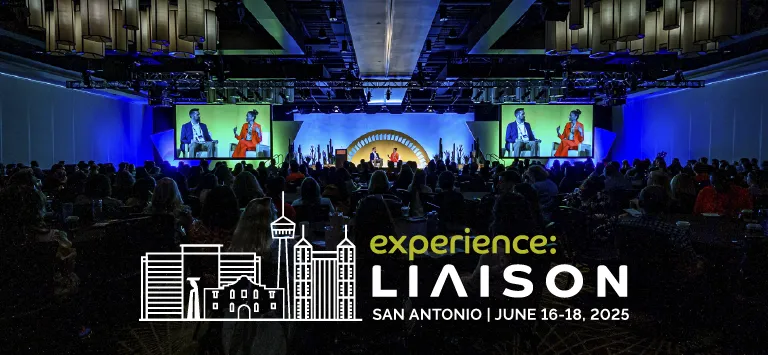Navigating the Currents: What We Learned at experience: LIAISON 2025

This year’s experience: LIAISON higher ed conference was more than just an annual meeting of minds, thought leaders, and community partners.
Table of Contents:
Key Takeaways
At experience: LIAISON 2025, challenges were named, ideas were shared, and a collective commitment to the future of education took shape.
Speakers emphasized the importance of embracing new mindsets, partnerships, and collaboration to achieve enrollment goals.
Panelists also highlighted the disruptive effects of shifting federal guidance, delayed FAFSA rollout, and scrutiny over DEI initiatives.
Get ready for experience: LIAISON 2026 in Baltimore!
In a story often told about anthropologist Margaret Mead, she’s asked what marks the beginning of civilization. Her answer isn’t what you’d expect: no tools or pottery. Instead, she points to a healed femur, evidence that someone paused their own progress to help another heal. Care, she said, is where civilization begins.
In higher education, we face pressures we can’t always control. As Liaison Founder and CEO George Haddad put it at experience: LIAISON in San Antonio last month:
“While we may not be able to steer the broader political currents, we can support our partners in navigating these changes and help them uphold their vital mission: educating the next generation of leaders.”
That spirit—of showing up for one another, of facing the moment honestly and working toward what’s next—is what defines our culture. And it's why we gather.
This year’s experience: LIAISON higher ed conference was more than just an annual meeting of minds, thought leaders, and community partners. It was our sign of care: a space where challenges were named, ideas were shared, and a collective commitment to the future of education took shape.
The Currents We’re Facing
Higher ed leaders today are navigating a complex sea of change, and the sessions at experience: LIAISON 2025 reflected that reality with both clarity and urgency.
Demographic Contraction & Declining Yield
In sessions like Changing Demographics and the New Reality for Graduate Schools, speakers didn’t sugarcoat it: Traditional student pipelines are shrinking, and the pressure to diversify recruitment strategies is intensifying amid ongoing disruption.
- Takeaway: Institutions must reconsider where and how they recruit. That means building stronger pipelines with employers, expanding regionally and globally, and rethinking program formats to attract adult and nontraditional learners.
Regulatory Shifts & Political Uncertainty
In The Federal Policy Update, panelists highlighted the disruptive effects of shifting federal guidance, delayed FAFSA rollout, and scrutiny over DEI initiatives. The rules of engagement are changing—and fast.
- Takeaway: Enrollment teams must be in regular contact with legal, policy, student success, international support, and financial aid colleagues. A shared understanding of risk, compliance, and emerging policy is no longer optional—it’s strategic.
Generative AI & the Enrollment Toolkit
In one of the most forward-looking sessions, AI and the Future of Admissions, panelists offered both excitement and caution. AI can streamline reviews, personalize outreach, and free up time—but only if implemented with clear ethical guardrails.
- Takeaway: Don’t wait. Set up an AI sandbox inside your enrollment office to test tools, evaluate outcomes, and develop governance protocols before others define the landscape for you.
What We Heard from Presenters
Beyond the market signals, higher education professionals at experience: LIAISON 2025 shed light on something harder to quantify but more essential: the importance of mindset shifts. Here are three messages that stayed with us, and what they mean in practice.
“The Future Won’t Wait for Us to Be Comfortable.”
One inspiring keynote speaker summed up the moment: Change is not coming—it’s already here. Institutions that hesitate will miss windows of opportunity that won’t reopen.
- Action: Run a mid-year audit of your enrollment practices. Ask: Where are we still operating on autopilot? What data is telling us it’s time to shift?
“The Application Is a Relationship, Not a Transaction.”
Sessions on inquiry management and application engagement emphasized the need for responsiveness, relevance, and relationship building, especially for today’s digital-native prospects.
- Action: Review your inquiry-to-application drop-off rates. Where are students disengaging? Are you answering their actual questions—or just sending more emails?
“Collaboration Is the New Competition.”
The most repeated refrain of the event came not from a single speaker, but from many higher ed professionals: In today’s environment, no institution succeeds in isolation. Peer collaboration, public-private partnerships, and shared platforms are key to building a sustainable enrollment path forward.
- Action: Identify one area—student support, career services, enrollment ops, tech infrastructure—where a partnership could create value and explore it before planning for next year begins.
What We Do Next
The conclusion of experience: LIAISON 2025 wasn’t the end of a conversation, but rather a point of convergence.
We now understand more clearly:
- Our current challenges aren’t temporary, they’re structural.
- Innovation is part of each institution’s ethical responsibility to students.
- Technology alone won’t solve all problems—enrollment teams and faculty members need to lead through disruption with leadership, community engagement, and mission focus.
Here’s what we invite you to do next:
- Reflect: What forces are shaping your part of the enrollment value chain most intensely?
- Act: Identify what you can change, test, or pilot before next year, and do it.
- Connect: Share this post with a colleague and start the conversation.
We’ll continue exploring these topics throughout the year in upcoming webinars, conversations with our leaders and partners, and our ongoing outreach to the enrollment management community.
Carrying the Torch
Baltimore awaits. A city shaped by revolution, resilience, and the power of voice. It’s the perfect backdrop for experience: LIAISON 2026, because what lies ahead for higher education will require more of us than tech and tactics. It will require courage. It will require us to show up for each other. It will require us to carry the torch, even when the winds shift.
Until then, let’s keep navigating, together.












